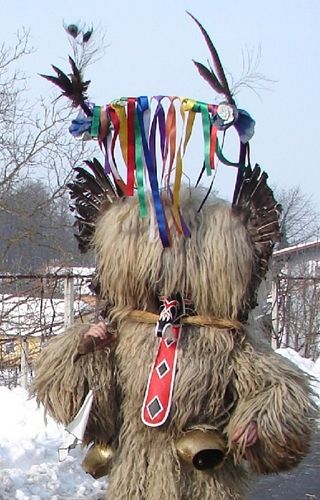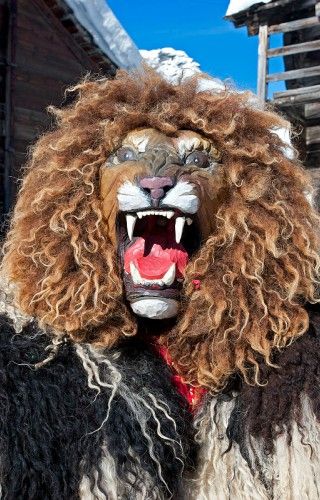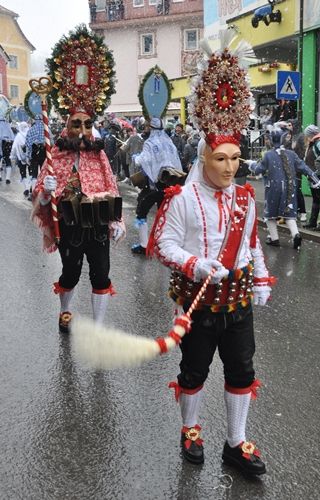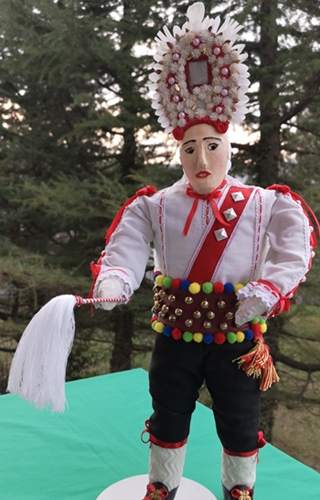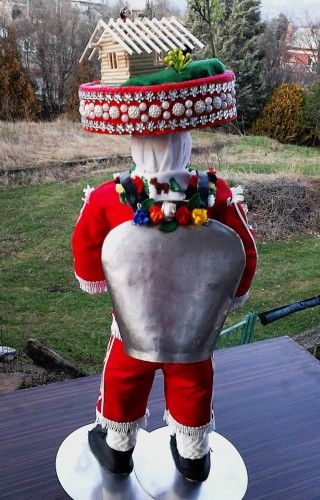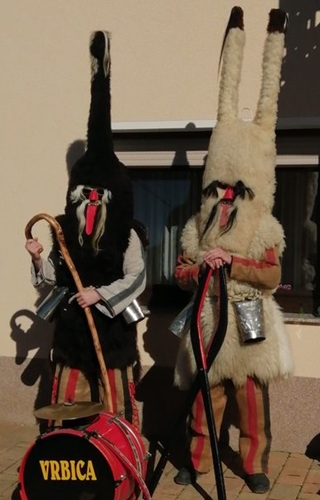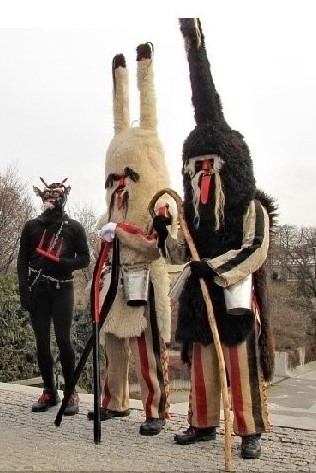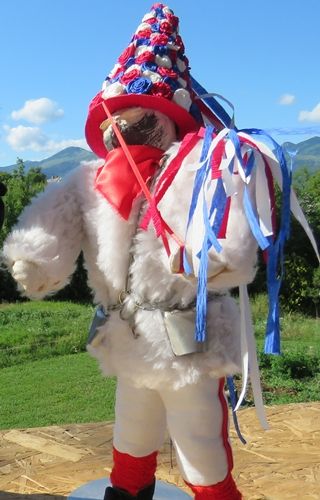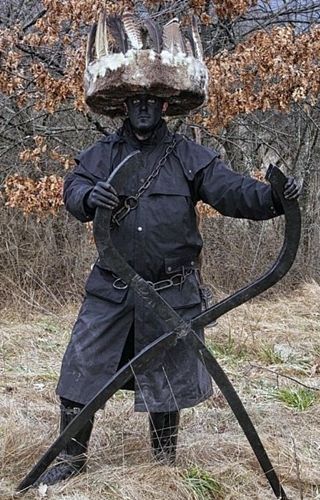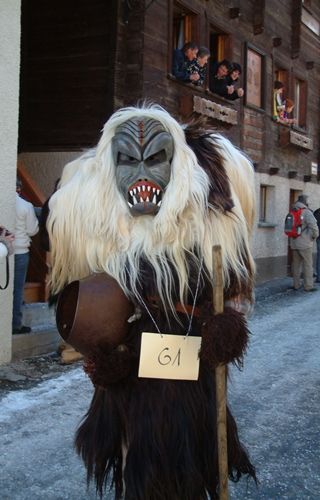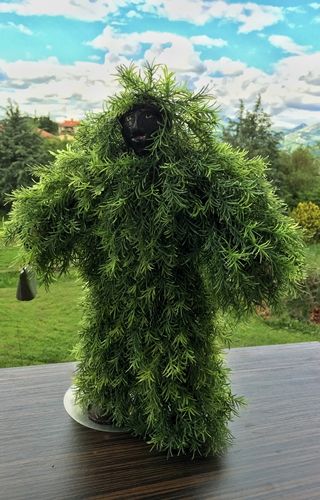HEXE (vještice)Tirol
The origin of the carnival witch has not yet been sufficiently clarified. The forerunners of today's witch figures have been handed down from the Middle Ages.The oldest surviving mask of a witch figure comes from Tyrol (old witch mother larva); it is dated to the 18th century . There are still witch figures on the Tyrolean carnival, for example during the „Imster Schemenaufen“.
The carnival witch figures of today are probably based on the witches known from fairy tales. The witches are an independent group of protagonists, whose performance is characterized by piercing shrieks, hideous looks and threatening brandishing of brooms.Their wooden masks consisting of two parts, a nose with eyes and an ugly chin covered with warts and bristles, allow them to produce their infernal howls.
When their dance is over and all witches have been heard, their Führungstroika (leading troika) is satisfied.
KLAUSEN (Immenstadt im Allgäu)
The custom of "Klausentreiben" is approximately 1,000 years old and can be traced back to old Celtic customs. In the past, people wanted to drive away demons with this custom and for that wanted to look more frightening than them. Costumes weigh up to 25 kilograms, and the participants make them themselves. Mostly the basic concept is: covered in fur from head to foot, a cow bell around the waist and horns on the head.rene. Only those who are members of the association, at least 16 years old and male may take part in the "Klausentreiben". Women are not excluded from the winter custom, however: they are generally involved in the same association as the men as so-called "Bärbele". The costumes are generally based on witches. Anyone who doesn't keep their distance during parade gets whipped by the twigs.Klausen usually hit people who invite it.
Amongst the younger people and, it is a popular test of courage to provoke the "Klausen" and the "Bärbele". "However, it is not always that easy to separate those who want to take part and those who just want to watch
KORANT / KURENT (Ptuj)
Kurent or Korant is the most famous traditional carnival figure of the entire region, and arguably, the most recognizable in all of Slovenia. While Kurent groups might not all look exactly the same, it is the most popular carnival figure in the Ptuj and Drava fields, and in the Haloze Hills. Kurent or Korant, as it is known today, has its origin in popular tradition. Traditionally, the Kurent's outfit was reserved for unmarried men, but nowadays Kurent-Korant can be unmarried or married men, as well as well women and children. The two types of Slovene Kurent-Korant are the so-called »feathery« (from the town of Markovci) and the »horned« ones (from Haloze), with the difference being mainly in the look of the head covering. The Kurent-Korant wears a massive sheepskin garment. Around its waist hangs a chain with huge bells attached—the resulting noise does a great job of chasing away winter, which is, ostensibly, the Kurent's function. The Korent also wears heavy boots and special red or green leg warmers, while the head is covered by a towering furry hat festooned with ribbons, and a mask typically sporting a long, red tongue.
A wooden club is normally carried in the left hand.
KRAMPUS (Tirol)
Krampus is a beast-like creature from the folklore of Alpine countries thought to punish children during the Christmas season who had misbehaved, in contrast with Saint Nicholas, who rewards well-behaved ones with gifts. Krampus is said to capture particularly naughty children in his sack and carry them away to his lair. He is represented as a beast-like creature, generally demonic in appearance. The creature has roots in Germanic folklore; however, its influence has spread far beyond German borders and across Europe. During the first week of December, particularly on the evening of 5 December and roam the streets frightening children with rusty chains and bells. All the masks are hand-carved in wood and the clothes are either made of common sheepskin (white) or of "Heidschnucke" skin (brown-grey-black).
The "Heidschnucke" is a sheep from Northern Germany.
PELUCHES & EMPAILLES
In Val d'Hérence, Switzerland, every year from January the 6th until the evening of Mardi Gras, before the Ash Wednesday, centuries-old carnival customs are being held. Then, strange creatures that come from the distant past could be met in the streets of Evolène The main characters are "Peluches" (once Patôye). They wear costumes made from the skin of sheep, goats, chamois, foxes, and sometimes even badgers. It's mostly unprocessed and has an unpleasant smell. Their face is covered with a hand-carved mask made from a wood named "Arolla". Masks are often colored and are called "Visagres". In the past, there were mostly representing animals such as cats, wolves and lions, but today their faces are diverse, so there are also mythological animals or even monsters straight from horror movies. They carry large cow bells in their hands that help them drive away evil spirits that bring the cold, illness and avalanches. "Empailles" are the most impressive carnival characters though. They appear only on the Sunday immediately after the Mass. Dressed in jute clothes filled with about 30 kilograms of straw, they are the center of attention of passers with their imposing mass and a special frenzied gaiting walk. Instead of a cane, they use a broom to assist themselves in walking. Their faces are concealed with scary masks. They symbolize the spirit of the ancestors and the return of good weather. On Mardi Gras they finally sacrifice a Snowman named "Poutratze".
The carnival officialy ends at midnight when the masks fall.
PERCHTEN (Tirol)
The word Perchten is plural for Perchta, and this has become the name of her entourage, as well as the name of animal masks worn in parades and festivals in the mountainous regions of Austria. In the 16th century, the Perchten took two forms: Some are beautiful and bright, known as the Schönperchten ("beautiful Perchten"). These come during the Twelve Nights and festivals to "bring luck and wealth to the people." The other form is the Schiachperchten ("ugly Perchten") who have fangs, tusks and horse tails which are used to drive out demons and ghosts. Men dressed as the ugly Perchten during the 16th century and went from house to house driving out bad spirits. Today in Austria, particularly Salzburg, where she is said to wander through Hohensalzburg Castle at dead of night, the Perchten are still a traditional part of holidays and festivals (such as the Carnival Fastnacht).
The wooden animal masks made for the festivals are today called Perchten.
ROLLATE (Sappada)
The “Rollate” were given the name from loud large bells which the tie to their waist with a chain (kettn). They wear a darke sheepskin (Pelz) that resembles the fur of a bear. It’s wide a nd falls down to their knees. Their head is completely surrounded with a large hood decorated by a piece of red wool on top (gormcioff). Rollate wear striped white and brown pants made of wool and linen, materials usually used to cover cattle in winter. They wear leather boots (aisnschui) that enable them to walk on icy ground without slipping. A wooden mask (lòrve) covers their face and alters the wearer’s voice who has to speak with people in falsetto (goschn). It’s always the face of a mature man, filled with authority. A true Rollate seems frightening just by looking at his face. Scarves around their neck (hòntich) differ in color depending on the marital status of the bearer: red for married men and white for single men. They use grey or brown woolen gloves to warm their hands and wield a broom made of heather branches (hadratpesn).
Rollate are tall and strong men and their sheer appearance is impressive
SCHELLER - ROLLER ( Imst – Tirol )
Carnival season includes some of the most important folk events of Tirol. Long past rites and customs are still lived here and include an array of magical and anxiously awaited spectacles. The Carnival season celebrates the natural changes of seasons. As with many Tirolean carnival customs, the festive parades are symbolic of the fight between the winter and the spring. The main protagonists of Fasnacht in Imst are Roller (jumper) and Scheller (ringer), they are at the center of the procession, radiating with splendor and dignity, representing gentle femininity and harsh masculinity, respectively. The sound of their little jingle bells and Schellen (larger bells) create the unique atmosphere of Schemenlaufen. Since when has Fasnacht existed in Imst? No one can give a reliable answer to this question. The oldest known documents, referring to Fasnacht, date back to 1597 and 1610. It can be assumed however, that the tradition reaches back much further. Was it a Germanic rite? Was it pagan? There are many theories, but little scientific proof.
SIlVESTERKLAUS (Appenzel)
The tradition is first mentioned in 1663, when church authorities objected to such a noisy behaviour. In the catholic half-canton of Appenzell Innerrhoden (AI), according to some 18th-century records, taking part in the «Chlausen» tradition was punished with a heavy fine of five thalers. Nevertheless, the tradition survived in the catholic half-canton on a small scale up to 1900, more or less tacitly tolerated by the local district authorities. Three different types of Silvesterchläuse can be distinguished. The «Beautiful» have very ornate embroidered headgear with scenes of peasant life, domestic customs and crafts, special buildings, sports, or family life, which take hundreds of hours of intensive work. Their dress resembles a local traditional costume. The «Pretty-Ugly» wear a costume made of fir twigs, ivy, moss and other natural materials, and a headgear similar in shape to those of the Beautiful, but also decorated with natural materials. The «Ugly» wear a costume made from the same materials as the «Pretty-Ugly», but coarser and more massive in appearance. On their head, they wear a hat or a helmet, artfully crafted but having a wild appearance. All characters hide their faces behind a mask, which is either sweet, and doll-like (Beautiful), finely covered with natural materials («Pretty-Ugly»), or scary looking («Ugly»).
The young people, in «Children’s groups», are usually without a mask.
ŠJME ( Vrbica)
The carnival group consists of about 60 characters, and the schemes are divided into black and white. All the carnival characters are in some way connected with the lives and destinies of the locals. The central characters are ‘beu louc’ and ‘black louc’ which we can view as two opposite poles, as a symbolic struggle between light and darkness, between winter and summer, between good and evil, between beginning and end. They are among the oldest preserved masks in Slovenia and have a permanent place in the Ethnological Museum in Ljubljana. They are wrapped in white and black sheepskin and wear jacquard pants. White carries pliers in his hands, and black a large curved stick. They have three bells around the waist. Masks reminiscent of a wild cat or lynx, red edge of the eye openings emphasize black and white eyebrows, made of horse mane. A long mustache hangs under his red nose, white teeth and a red tongue protrude below them. Black Louc runs in front of her with both hands horizontally holding a long curved stick, and White Louc has large wooden pliers with which she hunts children and girls to blacken them with sooty hands. In the old schemes there is also a puppet filled with straw, which represents the Pust itself. The procession must also include the devil, a squirrel, a bear with a gypsy man and a gypsy woman, a plowman with a wooden plow in which "uosli" are harnessed, peasants, a monkey, a camel, a merchant ...... On the other side are white masks, represented by couples in white clothes. They also include a large woman, who is a meter taller than other masks, and an ivy man (a person wrapped in ivy) holding a potter's bass in his hands. The peak reaches the Vrbički carnival on Shrove Sunday, when at a certain hour the schemes gather in the middle of the village. Then the silent theater comes to life, because the schemes must not speak.
ŠKOROMAT (Podgrad)
Carnival traditions in the villages next to Ilirska Bistrica start with preparations on Saint Stephen’s day, when all of the boys and men come together to assign roles. The main event is “poberija¨ in one of the villages. After the procession “Škoromati” visit all familiey, play prakns, dance with the local women, eat and drink with the denizens and if they wish to enter a home they must reveal to the host who came to him and ask if they had anything for the “Škoromati”. If they do, the “Škoromati” thank them for the gifts and wish them the best in the coming year. Besides “Škoromati” wearing bells (Gönci) that wear tall hats made of paper flowers and ribbons around their waists, well known are the “Škopiti” masks that carry large wooden pliers which they use to catch women, girls and children. The first known video document of the “Škoromati” was made in 1952., and the first written evidence of their existence which they use to prove their tradition dates back to 1340.
In Udine, region Friuli, when they banned the name “Scramatta”.
TSCHAGGATTA (Lötschental)
Tschäggättä, carnival figures typical to the Lötschental region, are instantly recognisable due to their carved wooden masks, mostly made from Swiss pine, their animal pelts (goat or sheep skin), and the bell that hangs from their belt. From 3 February – the day after Candlemas – to midnight on Shrove Tuesday, they rampage through the village streets in pursuit of women and children. Once caught, the Tschäggättä rub their icy gloves over the faces of their victims. Today, married men, women and children also don the masks, skins and bells of the Tschäggättä.
SMREKANI
One of the oldest and safest of the most widespread European masks. Phytomorphic characteristics vary very little in the matrix depending on their availability in different countries of Europe.
It's a traditional mask in:
Germany - Reisigbar
Austria - Wilder mann
Switzerland - Sauvages
Spain - Trapajones Italy -
Salmon Man
Slovenia - Smrekov or Green
Croatia - Smrekan
WUDELEN (Schnappviecher)
From January7, the Wudelen of Tramin spread terror in the streets of this wine village, and parrticipate in the procession of the egermann, held every other year on Shrove Tuesday. Butchers and the Drivers who accompany them struggle to contain these horned characters and to protect the public from them. When the procession passes a fountain – or the site of an old fountain – a Wudelen is slaughtered by a Butcher. Some interpret this gesture as the killing of winter. A large plough is also part of the procession – „Eget“ also means “harrow“. The public ara constantly smeared with sooi or make up, and sprinkled with hay, sawdust or confetti. The Schnappviecher – horned creatures Without ears but with metal tongues – can be an impressive size, up to three meters high. Their lower jaw is activated by means of a rope, while its wooden teeth produce a loud cracking noise. The origin of these characters is unknown.
Their appearance could link them to the dragons of religious imagination or of medieval epics and myths.













